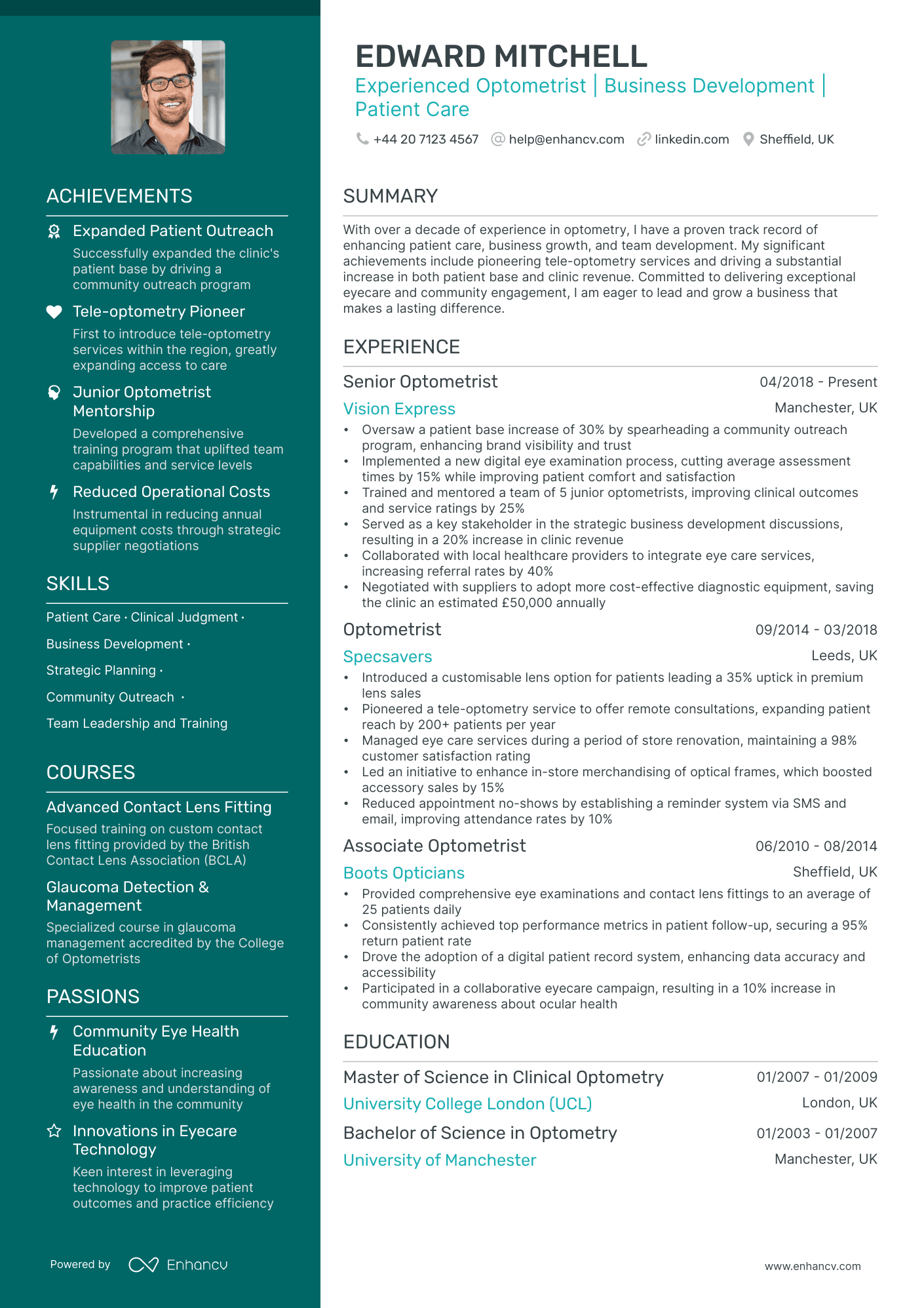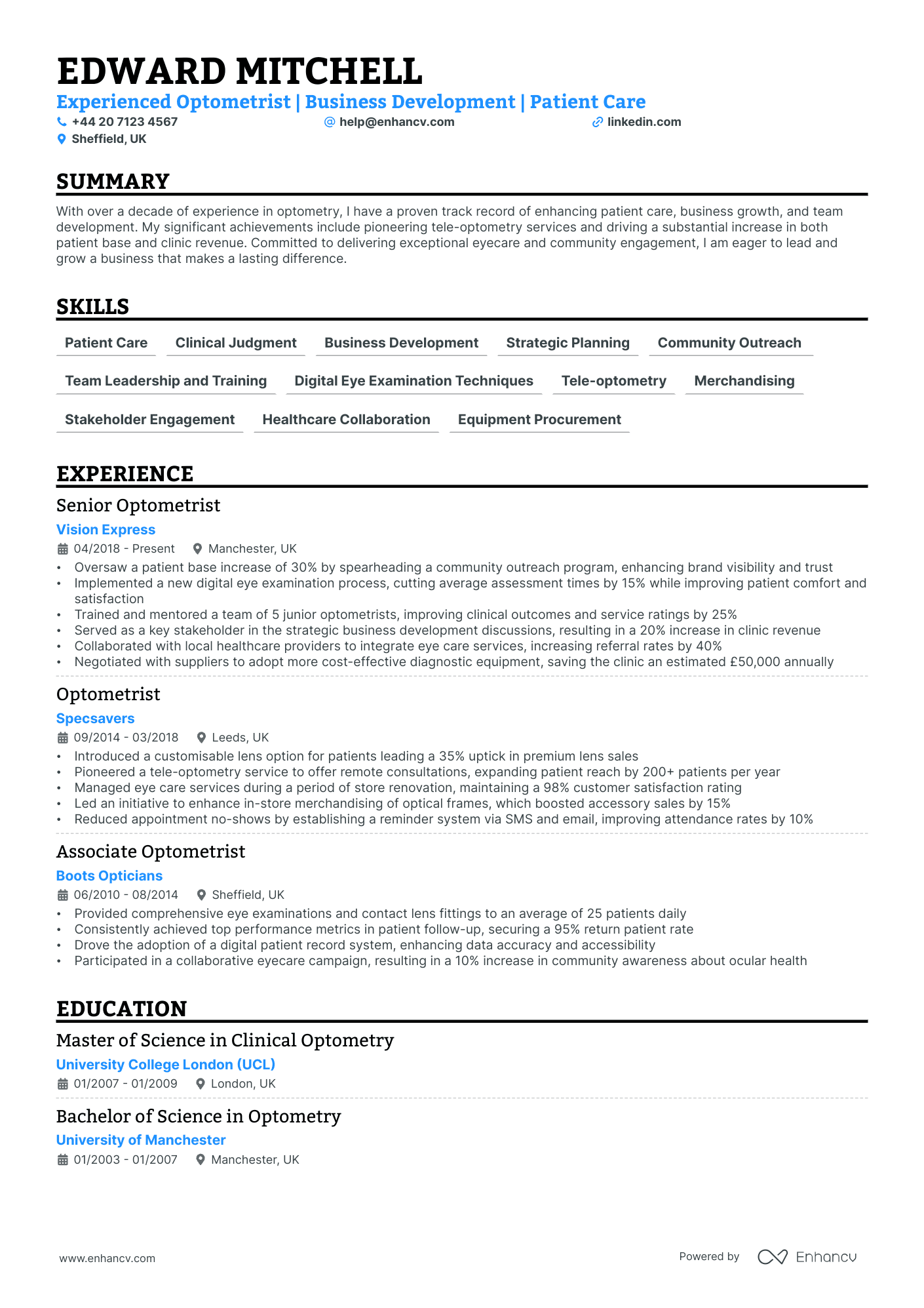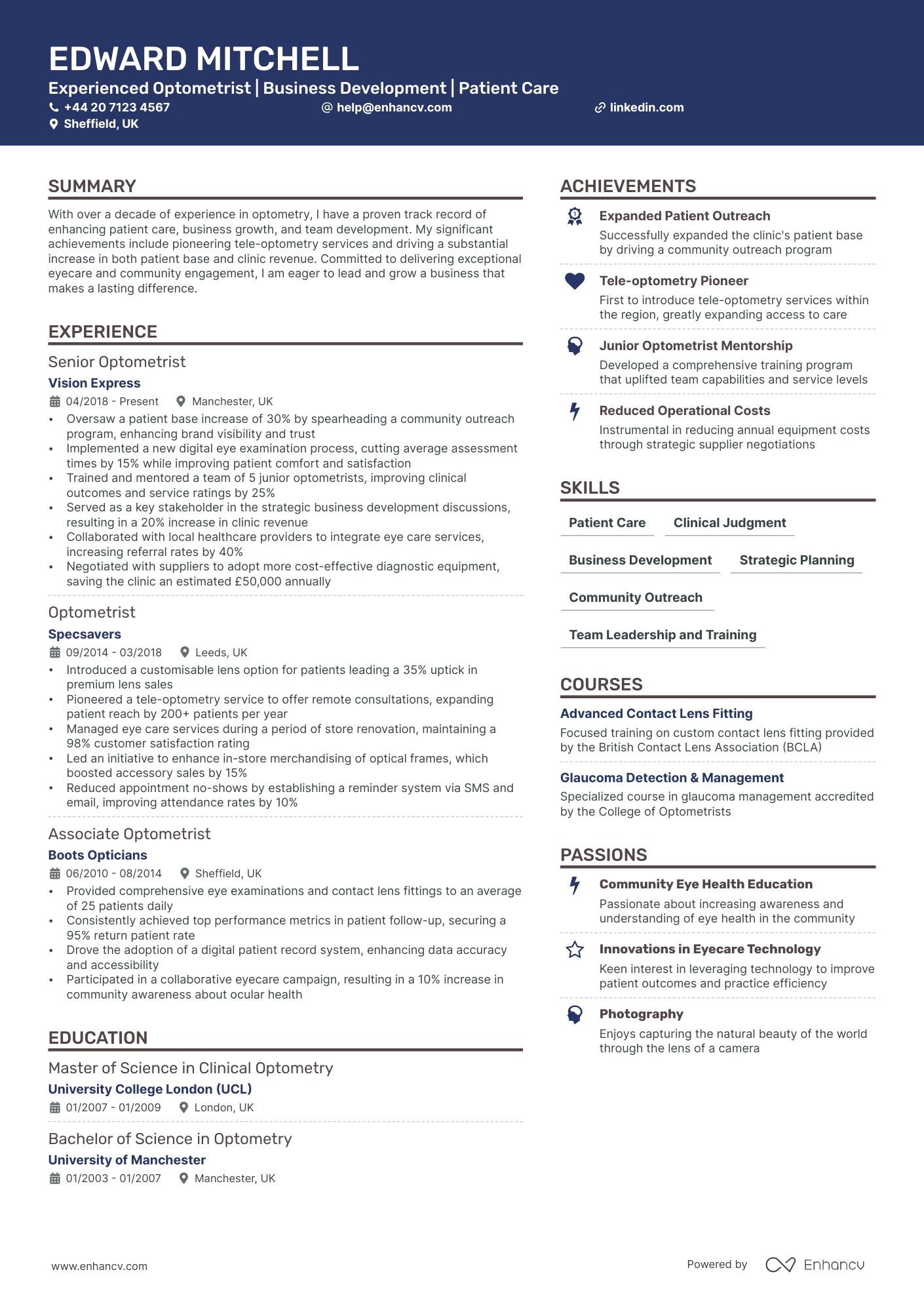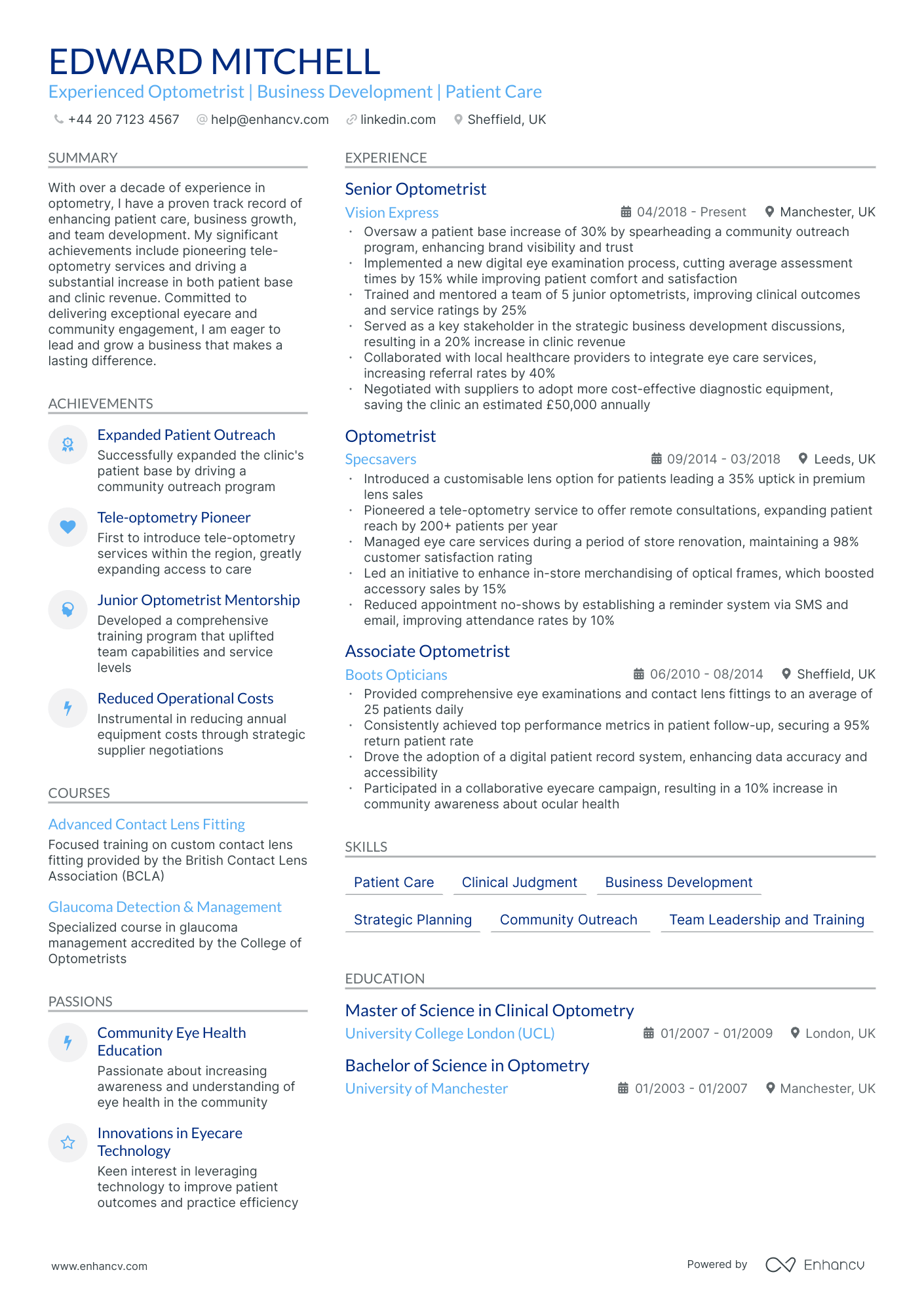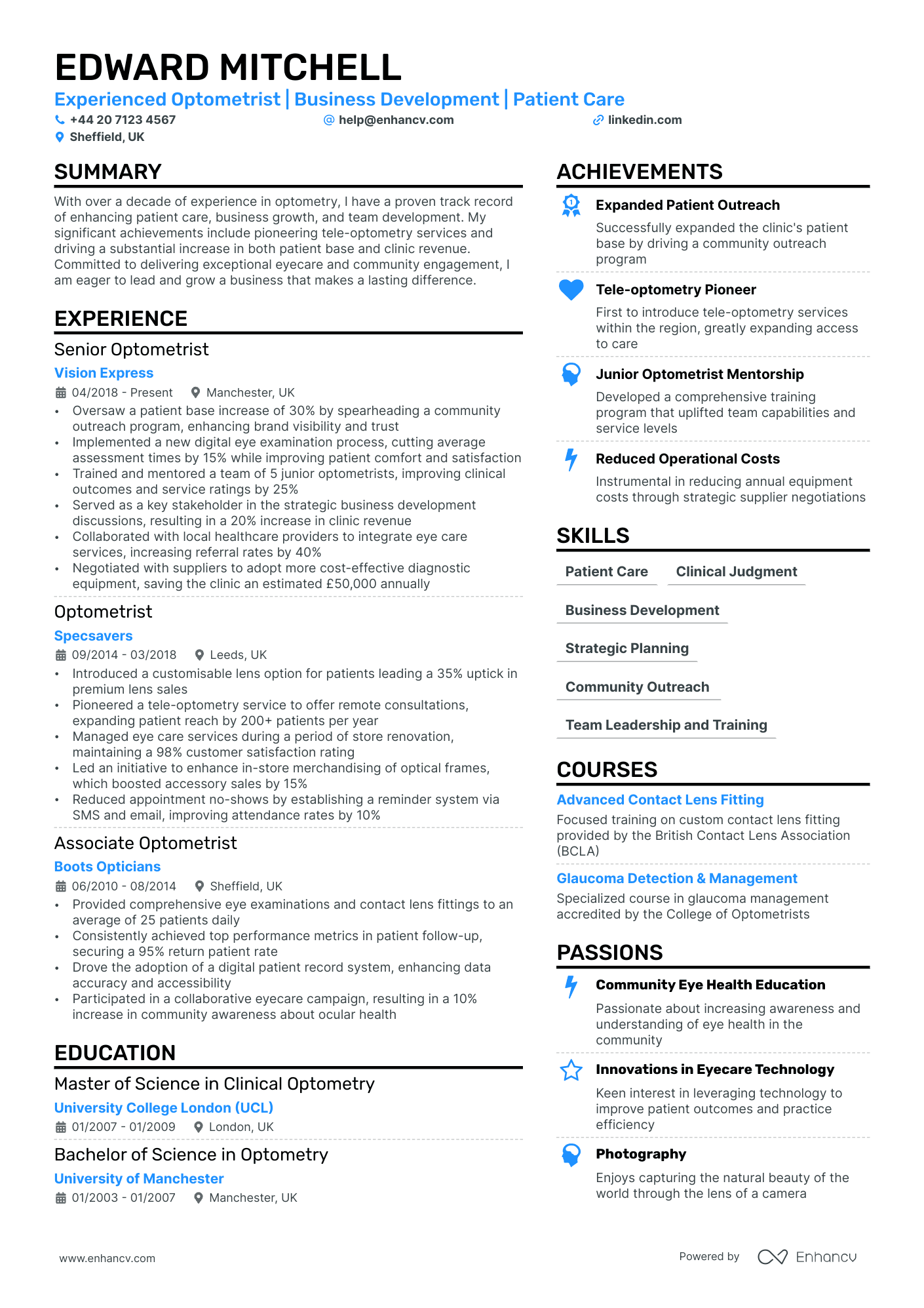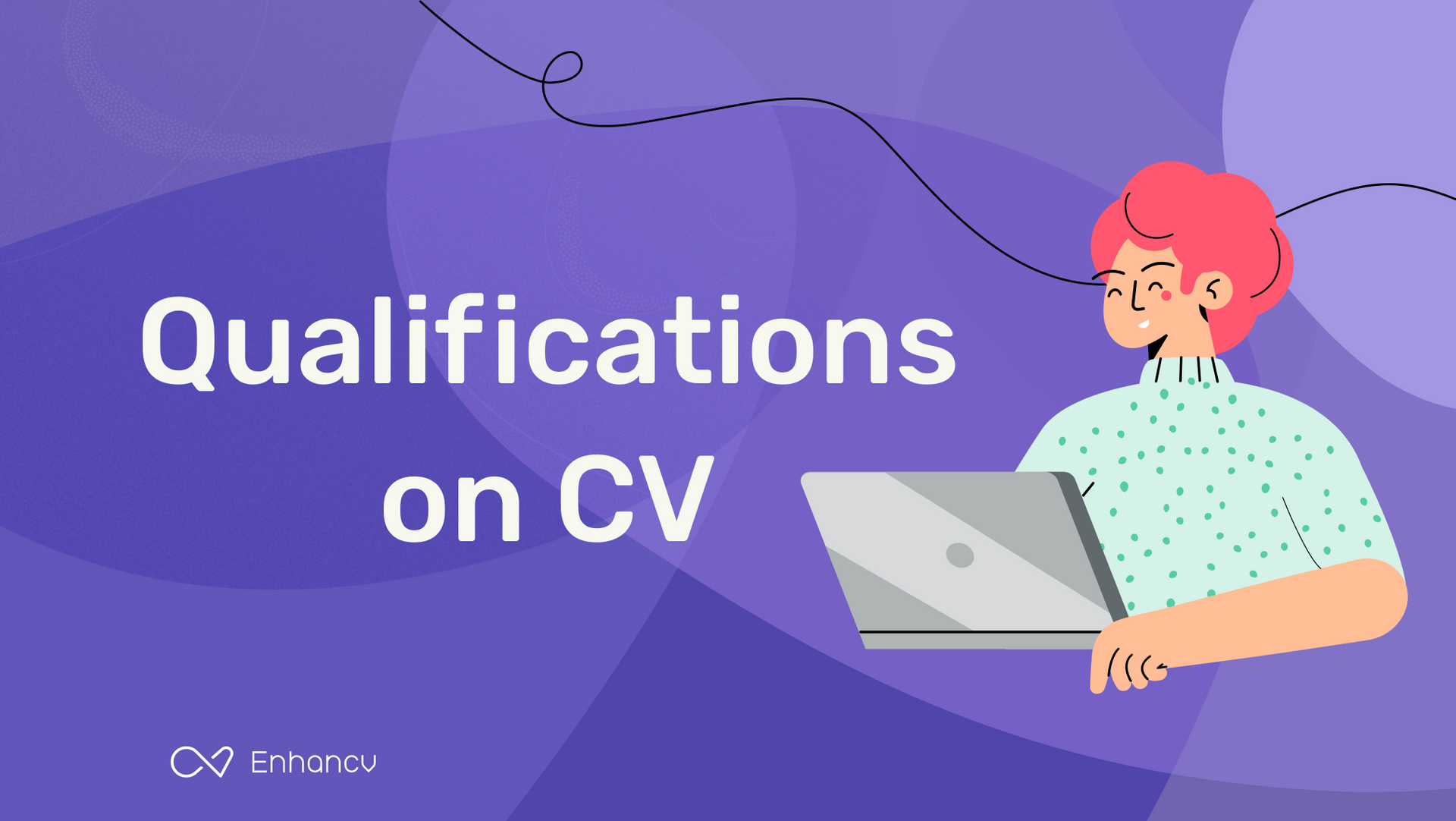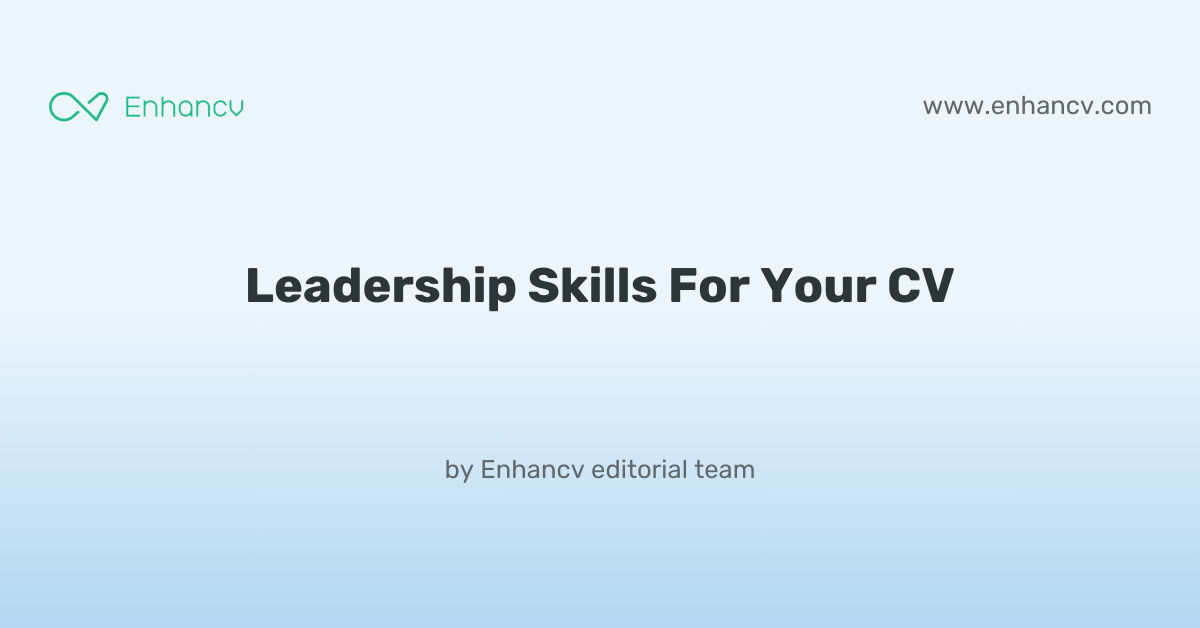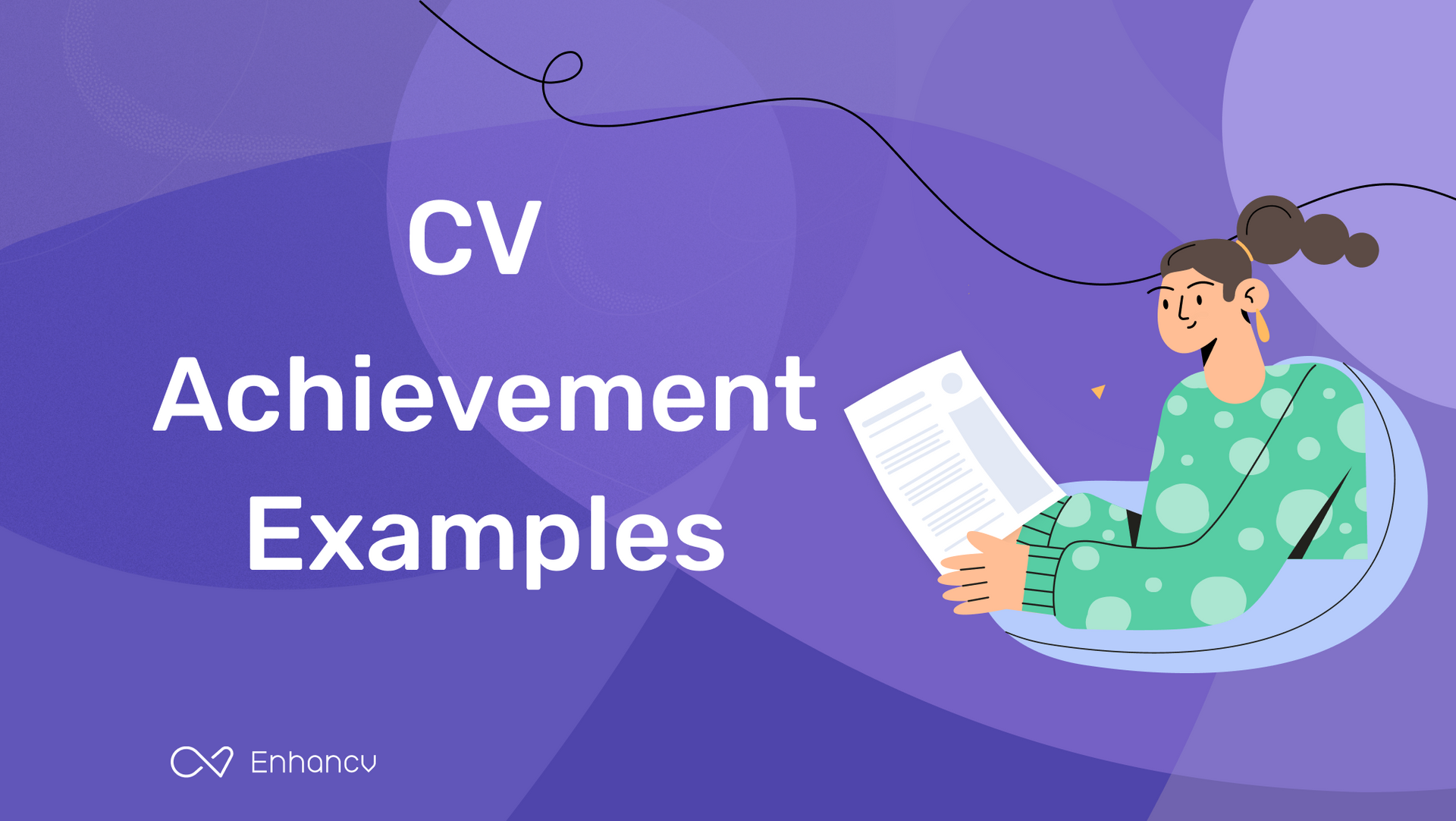Keeping up with the rapid advancements in ocular diagnostic technology stands as a significant CV challenge in the field of optometry. By delving into our comprehensive guide, you'll uncover practical strategies to enhance your CV, ensuring it accurately reflects your expertise with the latest innovations and sets you apart in the job market.
- Answer job requirements with your optometry CV and experience;
- Curate your academic background and certificates, following industry-leading CV examples;
- Select from +10 niche skills to match the ideal candidate profile
- Write a more succinct experience section that consists of all the right details.
Do you need more specific insights into writing your optometry CV? Our guides focus on unique insights for each individual role:
Formatting your optometry CV to meet the role expectations
Staring at the blank page for hours on end, you still have no idea how you should start your professional optometry CV. Should you include more colours, two columns, and which sections? What you should remember about your CV format is this - ensure it's minimalistic and doesn't go over the top with fancy fonts and many colours. Instead, focus on writing consistent content that actually answers the job requirements. But, how about the design itself :- Use the reverse chronological order to showcase your experience, starting with your most recent role;
- Include your contact details (email address, phone number, and location) - and potentially your professional photo - in the header;
- Must-have CV sections include summary or objective, experience, education, and skills: curate the ones that fit your profile;
- Your professional optometry CV should be between one-to-two pages long: select the longer format if you have more experience.
A little bit more about your actual CV design, ensure you're using:
- plenty of serif or sans serif font (e.g. Montserrat, Exo 2, Volkhov) as they are Applicant Tracker System (ATS) compliant. Avoid the likes of Arial and Times New Roman because most candidates' CVs are in this typography.
When submitting your CV, are you still not sure what format it should be? Despite the myth that has been circling around, most modern ATS systems are perfectly capable of reading PDFs. This format is an excellent choice as it keeps all of your information intact.
PRO TIP
Be mindful of white space; too much can make the CV look sparse, too little can make it look cluttered. Strive for a balance that makes the document easy on the eyes.
The top sections on a optometry CV
- Professional Registration clarifies the optometrist's accredited body.
- Clinical Skills and Competencies showcase expertise in eye care.
- Education and Qualifications confirm academic and professional training.
- Relevant Work Experience highlights practical optometry engagements.
- Optometry Awards and Honours demonstrate recognition and excellence in the field.
What recruiters value on your CV:
- Highlight your clinical experience by detailing the types of optometric services you've provided, such as eye exams, vision tests, diagnosis of visual diseases, and lens prescriptions.
- Include any specialisations or additional qualifications in optometry, for instance, if you are skilled in paediatric optometry, contact lens fitting, or have expertise in managing ocular diseases.
- Emphasise your patient care skills by mentioning your ability to communicate effectively, educate patients about eye care, and provide excellent customer service.
- Feature any technological proficiencies you have with optometric equipment and software, such as visual field analysers, retinal cameras, or electronic health records.
- Document your professional affiliations and contributions to the field, like memberships in optometric societies or involvement in research, to demonstrate your commitment to the profession.
Recommended reads:
What information should you include in your optometry CV header?
The CV header is potentially the section that recruiters would refer to the most, as it should include your:
- Contact details - your professional (non-work) email address and phone number;
- Professional photograph - if you're applying hinting at the value you bring as a professional.
Many professionals often struggle with writing their optometry CV headline. That's why in the next section of this guide, we've curated examples of how you can optimise this space to pass any form of assessment.
Examples of good CV headlines for optometry:
- Lead Optometrist | Glaucoma Specialist | MSc in Clinical Optometry | 10+ Years Experience
- Associate Optometrist | Paediatric Eye Care Expert | BSc Optometry | 5 Years Clinical Practice
- Senior Optometrist | Contact Lens & Refraction | PhD Vision Science | 15+ Years Professional Insight
- Consultant Optometrist | Low Vision Aid Authority | FCOptom | 20 Years Dedicated Service
- Specialist Optometrist | Myopia Control Innovator | DipOptom | 8 Years Progressive Experience
- Optometry Manager | Business Strategy & Patient Care | MOptom | 12 Years Industry Leadership
Choosing your opening statement: a optometry CV summary or objective
At the top one third of your CV, you have the chance to make a more personable impression on recruiters by selecting between:
- Summary - or those three to five sentences that you use to show your greatest achievements. Use the CV summary if you happen to have plenty of relevant experience and wish to highlight your greatest successes;
- Objective - provides you with up to five sentences to state your professional aims and mission in the company you're applying for
CV summaries for a optometry job:
The best formula for your optometry CV experience section
The CV experience section is the space where many candidates go wrong by merely listing their work history and duties. Don't do that. Instead, use the job description to better understand what matters most for the role and integrate these keywords across your CV. Thus, you should focus on:
- showcasing your accomplishments to hint that you're results-oriented;
- highlighting your skill set by integrating job keywords, technologies, and transferrable skills in your experience bullets;
- listing your roles in reverse chronological order, starting with the latest and most senior, to hint at how you have grown your career;
- featuring metrics, in the form of percentage, numbers, etc. to make your success more tangible.
When writing each experience bullet, start with a strong, actionable verb, then follow it up with a skill, accomplishment, or metric. Use these professional examples to perfect your CV experience section:
Best practices for your CV's work experience section
- Demonstrated proficiency in conducting comprehensive eye exams, accurately diagnosing vision problems and eye diseases, and prescribing corrective lenses and medications.
- Experienced in utilising the latest optometric equipment and technologies, such as OCT, fundus cameras, and corneal topographers, for advanced patient assessment.
- Skilled in fitting contact lenses, including specialty lenses for conditions like astigmatism, keratoconus, and post-surgical correction, ensuring optimal comfort and vision.
- Expertise in managing ocular emergencies, providing immediate care for conditions like ocular trauma, foreign bodies, and acute infections.
- Implemented patient-friendly initiatives that improved appointment scheduling, patient education, and satisfaction in an optometric practice.
- Proven track record of working collaboratively with ophthalmologists for co-management of pre-operative and post-operative cataract and LASIK patients.
- Designed and conducted community eye care programs, such as vision screenings and health talks, promoting eye health awareness.
- Successfully adapted to a range of practice settings, including high street opticians, hospital eye services, and specialty clinics for conditions like glaucoma and macular degeneration.
- Engaged in continuous professional development, attending conferences and seminars to stay updated with advancements in optometric care and treatment options.
- Performed comprehensive eye exams on over 30 patients per week, identifying vision problems and health issues like hypertension and diabetes.
- Implemented a new patient follow-up protocol that increased patient retention by 20% within the first year.
- Collaborated with paediatricians to develop a child-friendly eye examination process that improved the clinic's family service offerings.
- Managed a team of 5 optometrists, scheduling shifts and organizing continuing education to improve service quality.
- Increased the range of optical products available in the practice, leading to a 15% growth in annual sales.
- Spearheaded the adoption of digital retinal photography, enhancing diagnostic accuracy and patient outcome.
- Provided specialised care in managing ocular diseases, successfully treating over 500 cases of advanced glaucoma and cataracts.
- Conducted research on new methods of myopia control, contributing findings to an industry-leading journal.
- Introduced a patient education initiative that resulted in a 25% improvement in compliance with treatment plans.
- Expanded clinic operations to include a full-service optical lab, reducing external costs by 30% and improving turnaround time for eyewear fulfillment by 50%.
- Launched a community outreach program offering free vision screenings, educating over 1,000 community members about eye health annually.
- Optimised the appointment booking system, resulting in a 40% reduction in wait times and significantly improving client satisfaction.
- Developed and led a comprehensive eye care program tailored to elderly patients, enhancing quality of life for over 300 residents in local care homes.
- Orchestrated the integration of advanced OCT imaging technology, elevating diagnostic precision in macular degeneration cases.
- Curated a selection of specialist lens treatments, resulting in the practice becoming a regional leader in custom vision solutions.
- Led a project to introduce tele-optometry services, connecting with remote patients and increasing practice reach by 35%.
- Coordinated a sunglasses and sports eyewear sales event that generated a record-breaking £50,000 in sales over a single weekend.
- Developed a referral program with local businesses that increased new patient appointments by 10%.
- Solely responsible for conducting vision therapy sessions, improving visual performance for over 200 patients with amblyopia and binocular vision disorders.
- Authored an educational booklet on eye health that was distributed in the community and praised by local health authorities.
- Negotiated with suppliers to introduce an eco-friendly frames line, appealing to environmentally conscious consumers and increasing related sales by 18%.
- Launched the first dry eye clinic in the area, using pioneering treatment methods to provide relief to over 1,000 patients.
- Guided a team expansion plan, onboarding and training 3 new optometrists to meet growing clinic demands.
- Implemented a new inventory management system that reduced eyewear stock discrepancies by 90%.
Writing your CV without professional experience for your first job or when switching industries
There comes a day, when applying for a job, you happen to have no relevant experience, whatsoever. Yet, you're keen on putting your name in the hat. What should you do? Candidates who part-time experience , internships, and volunteer work.
Recommended reads:
PRO TIP
Include examples of how you adapted to new tools, environments, or work cultures, showing your flexibility.
Key optometry CV skills: what are hard skills and soft skills
Let's kick off with the basics. You know that you have to include key job requirements or skills across your CV. For starters, take individual skills from the job description and copy-paste them into your CV, when relevant. Doing so, you'll ensure you have the correct skill spelling and also pass the Applicant Tracker System (ATS) assessment. There are two types of skills you'll need to include on your CV:
- Hard skills - technical abilities that are best defined by your certificates, education, and experience. You could also use the dedicated skills section to list between ten and twelve technologies you're apt at using that match the job requirements.
- Soft skills - your personal traits and interpersonal communication skills that are a bit harder to quantify. Use various CV sections, e.g. summary, strengths, experience, to shine a spotlight on your workspace achievements, thanks to using particular soft skills.
Remember that your job-winning CV should balance both your hard and soft skills to prove your technical background, while spotlighting your personality.
Top skills for your optometry CV:
Clinical Eye Care
Visual Acuity Testing
Diagnosis of Eye Diseases
Patient Education
Prescription of Corrective Lenses
Knowledge of Contact Lens Fitting
Ophthalmic Instrumentation Proficiency
Understanding of Ocular Pharmacology
Glaucoma Management
Digital Retinal Imaging
Communication Skills
Problem-Solving
Empathy
Attention to Detail
Interpersonal Skills
Time Management
Patient Care
Professionalism
Adaptability
Continuous Learning
PRO TIP
Focus on describing skills in the context of the outcomes they’ve helped you achieve, linking them directly to tangible results or successes in your career.
CV education and certificates: your academic background as proof of your skill set
A common misconception about your optometry CV education is that you only need it, if you have less professional experience. That is completely false. The CV education section serves to back up your technical (and sometimes personal) capabilities, fill in gaps in your work history, and show you have the initial industry background and know-how. When creating your education section:
- List your degrees in the reverse chronological order, starting with the most recent (and relevant) ones first;
- Include your degree and university names, start and graduation dates. It's optional to also denote you received a "First-Class Honours" for diplomas that are more relevant to the role;
- Curate your relevant university coursework, projects, or thesis work if you happen to have less professional expertise and need to integrate more job keywords and skills.
Your professional qualifications don't need to stop at your academic background. It's advisable to also select up to three of your most noteworthy (and relevant) industry certificates and feature them in a dedicated section. Once more, include the certificate name, the institution that issued it out, and the date you obtained it on. You could feature both hard skills and soft skills certificates, as in the examples below:
PRO TIP
If there's a noticeable gap in your skillset for the role you're applying for, mention any steps you're taking to acquire these skills, such as online courses or self-study.
Recommended reads:
Key takeaways
What matters most in your optometry CV-writing process is for you to create a personalised application. One that matches the role and also showcases your unique qualities and talents.
- Use the format to supplement the actual content, to stand out, and to ensure your CV experience is easy to comprehend and follows a logic;
- Invest time in building a succinct CV top one third. One that includes a header (with your contact details and headline), a summary or an objective statement (select the one that best fits your experience), and - potentially - a dedicated skills section or achievements (to fit both hard skills and soft skills requirements);
- Prioritise your most relevant (and senior) experience closer to the top of your CV. Always ensure you're following the "power verb, skill, and achievement" format for your bullets;
- Integrate both your technical and communication background across different sections of your CV to meet the job requirements;
- List your relevant education and certificates to fill in gaps in your CV history and prove to recrutiers you have relevant technical know-how.
